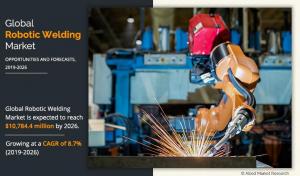Robotic Welding Market Size Global Forecast, Growth Report, 2026
Global robotic welding market size was valued at $5,450.5 million in 2018, and is projected to reach $10,784.4 million by 2026, growing at a CAGR of 8.7%
PORTLAND, UNITED STATES, UNITED STATES, June 21, 2023/EINPresswire.com/ -- Robotic welding is a process that utilizes robots to automate the welding process in industrial production. This process is becoming increasingly popular due to its ability to reduce labor costs, increase production speed, and improve the quality of welds. global robotic welding market size was valued at $5,450.5 million in 2018, and is projected to reach $10,784.4 million by 2026, growing at a CAGR of 8.7% from 2019 to 2026. This growth is driven by the increasing demand for automated welding processes and the need to reduce labor costs.
Download Free Sample PDF Now With Updated & Valuable Insights (215 Pages) https://www.alliedmarketresearch.com/request-sample/6200
COMPETITION ANALYSIS
The key market players profiled in the report of robotic welding market include ABB, Ltd., DAIHEN Corporation, Denso Corporation, Fanuc Corporation, Kawasaki Heavy Industries, Ltd., KUKA AG, Nachi-Fujikoshi Corp., Panasonic Corporation, Siasun Robot & Automation Co Ltd., and Yaskawa Electric Corporation.
Market dynamics
Robotic welding is used in various industries including automotive, construction, aerospace, and electronics. In the automotive industry, robotic welding is used to weld parts such as doors, roofs, and body panels. In the construction industry, robotic welding is used to construct bridges, buildings, and other structures. In the aerospace industry, robotic welding is used to join parts such as fuselage and engines. In the electronics industry, robotic welding is used to connect components such as wires and circuit boards.
Robotic welding systems are available in various forms, including arc welding robots, laser welding robots, and resistance welding robots. Arc welding robots are the most commonly used type of robotic welding system, and they are used for welding metals such as aluminum, stainless steel, and carbon steel. Laser welding robots are used for welding thin materials such as plastic and paper. Resistance welding robots are used for welding metals such as aluminum and copper.
Make a Purchase Inquiry - https://www.alliedmarketresearch.com/purchase-enquiry/6200
Segmental Overview
The global robotic welding market is analyzed based on four regions, namely North America, Europe, Asia-Pacific, and LAMEA. Asia-Pacific accounted for highest share in terms of revenue in 2018 owing to the government initiatives such as Make in India and Made in China 2025. In addition, increase in adoption of automated systems in the automotive, and other sectors; improved & safe working conditions; and technological advancements foster the demand for welding robots in this region. China has witnessed rapid growth in the robotics industry. The country has been investing heavily and deploying 100,000 industrial robots in several industries, which is fueling the demand for welding robots.
The Key Players
The major players operating in the global robotic welding market have adopted key strategies such as product development to strengthen their market outreach and sustain the stiff competition in the market. For instance, in July 2017, Fanuc Corporation launched Arc Mate 100iD welding robot. It supports several intelligent functions such as built-in vision systems that include the Fanuc-developed iRVision system. Sensors and parts such as additional seam tracking sensors, cameras, and gripping devices are also compatible with the new robot. Similarly, in March 2019, it launched two new models: the M-20iD/25 handling robot, and the ARC Mate 120iD welding version, which delivers productivity improvements using its superior motion performance along with lower ownership costs.
In conclusion, the global robotic welding market is expected to witness significant growth in the coming years. This growth is driven by the increasing demand for automated welding processes and the need to reduce labor costs. The major players in the market are focusing on developing new products and technologies to stay ahead of their competitors.
Buy Now - https://www.alliedmarketresearch.com/checkout-final/66f6af351425e6c2da5e19a2d0f2cc2f
David Correa
Allied Analytics LLP
+15038946022 ext.
email us here
Legal Disclaimer:
EIN Presswire provides this news content "as is" without warranty of any kind. We do not accept any responsibility or liability for the accuracy, content, images, videos, licenses, completeness, legality, or reliability of the information contained in this article. If you have any complaints or copyright issues related to this article, kindly contact the author above.

